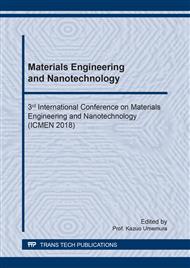p.8
p.14
p.20
p.25
p.31
p.37
p.42
p.47
p.53
Natural Rubber Reinforced with Silica Nanoparticles Extracted from Jasmine and Riceberry Rice Husk Ashes
Abstract:
Silica nanoparticles were synthesized by rice husk ash (RHA) produced from jasmine rice husk and riceberry rice husk via sol-gel method for the use as reinforcing fillers in natural rubber (NR). The obtained silica nanoparticles are spherical in shape and the particle sizes were observed to be in the 10-20 nm range with uniformly size distribution. The surface of silica nanoparticles was treated with a silane coupling agent confirmed by FTIR. The treated silica nanoparticles were then incorporated into NR and vulcanized with electron beam irradiation. The rubber nanocomposites with silica nanoparticles, produced from jasmine rice husk and riceberry rice husk, resulted in higher mechanical properties (tensile strength and modulus) than neat rubber vulcanizate. The modified rubber vulcanizates revealed rougher surface with tear lines as compared to the neat rubber vulcanizates, indicating the improved strength. Interestingly, the rubber nanocomposites with silica nanoparticles from jasmine rice husk showed higher tensile strength and modulus than silica nanoparticles produced from riceberry rice husk. The micrographs indicated better dispersion of NR composites with jasmine rice husk which leads to a strong interaction between silica nanoparticles and rubber matrix, thereby improving the strength.
Info:
Periodical:
Pages:
31-36
Citation:
Online since:
October 2018
Price:
Сopyright:
© 2018 Trans Tech Publications Ltd. All Rights Reserved
Share:
Citation:


